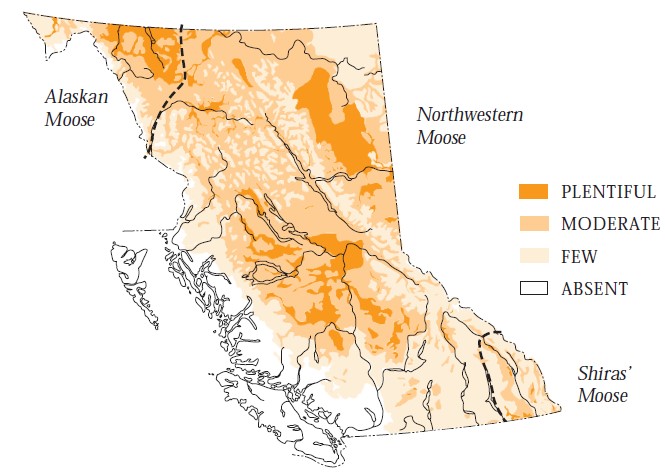Moose
Moose (Alces alces) are the largest members of the deer family. British Columbia has three subspecies of Moose, Northwestern Moose (andersoni), Alaskan Moose (gigas) and Shiras’ Moose (shirasi).

About Moose
- Adult males stand nearly 2 m tall and have the largest antlers of any member of the deer family.
- Female moose (cows) weigh on average about 340 to 420 kg while males (bulls) weigh 450 to 500 kg.
- Only male Moose have antlers, which they grow and shed each year. In British Columbia, Moose shed their antlers between mid-November and March. The older bulls shed earliest, and by March only the yearlings may still have antlers.
- The antlers begin to develop in late April or early May. While they are growing, the antlers are covered with furry velvet, which contains their nourishing blood supply. In British Columbia, Moose antlers reach full size by early September. Then the velvet dries, and the Moose rubs it off against trees or shrubs.
- Yearling bulls grow small antlers with two or three points on each side but with no significant palm. The antlers of older Moose are usually palmate (the angles between the tines are partly filled in to form a broad flat surface), but they vary greatly in size and number of points and are not a reliable means of determining the Moose’s age. However, most antlers have reached their maximum size when a Moose is about ten years old.
Distribution and abundance of Moose in B.C.
Moose are one of the most widely distributed ungulates in British Columbia. Found across almost the entire interior of the province, they are most abundant in the central and sub-boreal interior, the northern boreal mountains, and the boreal plains of northeastern British Columbia.
British Columbia has an estimated 115,000 to 192,00 Moose. Over 70 percent live in northern British Columbia and the rest in the Cariboo-Chilcotin, Thompson-Okanagan, and Kootenay regions. Population densities vary greatly from place to place, mostly in response to snowdepth and the supply of winter browse.
Moose populations are inventoried using aerial surveys by management unit. Surveys are planned for each important management unit once every 5 years. Data are extrapolated from manage unit estimates. Where possible moose surveys are designed to collect information on both population size and bull-to-cow ratios in the populations.

Life History of Moose
Moose are essentially solitary animals that move about within familiar summer and winter home ranges. In a given season, their home range seldom exceeds 5 to 10 km2. Their annual home range is much larger, particularly for migratory Moose. Moose do not defend their home range and do not have year-round dominance hierarchies like the more social Elk and Bighorn Sheep. In expansive northern shrublands, Moose commonly form groups of up to eight to ten during the rutting period. This habit is less common in forested habitats. When several Moose are attracted to a mineral lick or a superior feeding place, they may form a small group, but these groups lack a social basis. The Moose's only lasting social bond is the bond between mother and calf, and it lasts for only a year. During that time the cows protect the calves from predators and lead them to the best habitats.
In British Columbia, Moose mate from September to November. In late May and June, after a gestation period of eight months, the birthing period approaches. Under normal conditions, single births are the rule, and only 10 to 20 percent of adult cows produce twins. Newborn calves typically weigh 11 to 16 kg and can stand on their first day. Most cows produce one or two calves every year during their lifetime. Yearling bulls are capable of breeding, but older bulls are responsible for most of the successful breeding. The main natural causes of death in Moose are starvation and predators. Humans are responsible for losses from hunting and from collisions with trains and vehicles. During the most severe winters when the snow cover is unusually deep and long-lasting, Moose can be in poor physical condition, especially when they are older, have underlying disease or previous injuries and may die from starvation or attacks by wolves. Black Bears can take significant numbers of newborn calves. Grizzly Bears also kill Moose from spring through fall, and Cougars occasionally kill Moose in the southern interior.
Learn more about keeping Moose healthy.
Learn more about how the province manages moose populations.
Contact information
Call RAPP at 1 877 952-7277 for injured or distressed wildlife or wildlife interactions where public safety may be at risk.
For all wildlife health inquiries or reports, contact BC Wildlife Health.
